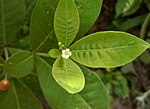en
names in breadcrumbs


The latex has been reported to be emetic, cathartic, and expectorant and is used for treating dropsy. The fruit juice is used as a substitute for ink.
Rauvolfia tetraphylla is a plant in the family Apocynaceae, growing as a bush or small tree. It is commonly known as the be still tree[2] or devil-pepper. The plant is native to Mexico, Central America, West Indies, and northern South America. It has been cultivated widely as both an ornamental and for use in traditional medicine. It is now naturalized throughout the tropics including Australasia, Indochina, and India.

Rauvolfia tetraphylla fruits are called devil-peppers and hold an important position in the Indian traditional system of medicine. The plant has various significances and it is widely used by South Indian tribes.
Asima Chatterjee initiated chemical investigation of alkaloids in Rauvolfia tetraphylla then known as Rauwolfia canescens. Indole alkaloids including serpentine, reserpine, serpentinine, and other Rauwolfia alkaloids were identified in phytochemical study.
Rauvolfia tetraphylla is a plant in the family Apocynaceae, growing as a bush or small tree. It is commonly known as the be still tree or devil-pepper. The plant is native to Mexico, Central America, West Indies, and northern South America. It has been cultivated widely as both an ornamental and for use in traditional medicine. It is now naturalized throughout the tropics including Australasia, Indochina, and India.
 Rauvolfia tetraphylla plant captured in West Bengal, India.
Rauvolfia tetraphylla plant captured in West Bengal, India.  Flower and fruits in West Bengal, India.
Flower and fruits in West Bengal, India.  A tiny white flower of Rauvolfia tetraphylla
A tiny white flower of Rauvolfia tetraphylla  Fruits of devil-pepper (Rauvolfia tetraphylla) in West Bengal, India.
Fruits of devil-pepper (Rauvolfia tetraphylla) in West Bengal, India.  Close-up of fruits
Close-up of fruits Rauvolfia tetraphylla fruits are called devil-peppers and hold an important position in the Indian traditional system of medicine. The plant has various significances and it is widely used by South Indian tribes.
Asima Chatterjee initiated chemical investigation of alkaloids in Rauvolfia tetraphylla then known as Rauwolfia canescens. Indole alkaloids including serpentine, reserpine, serpentinine, and other Rauwolfia alkaloids were identified in phytochemical study.